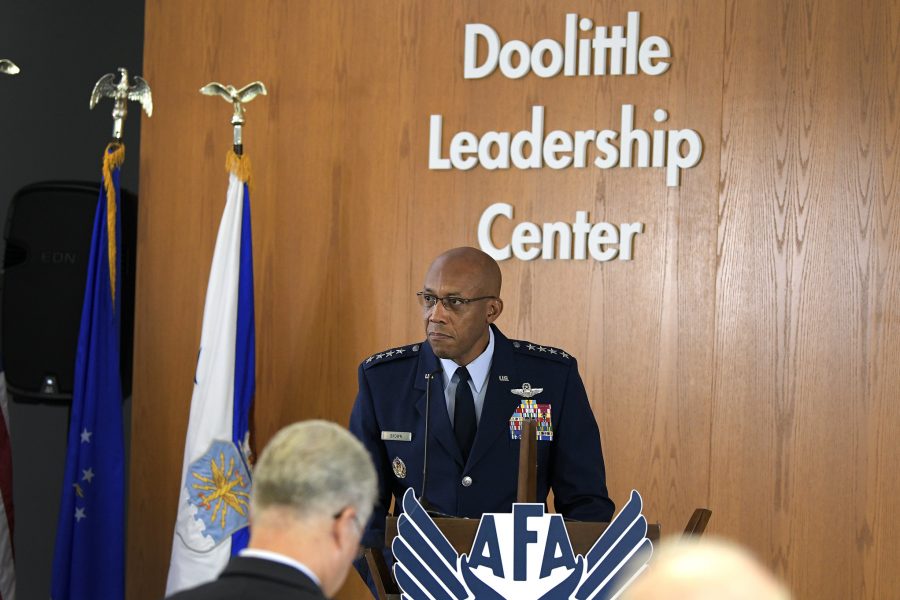In the opening weeks of his tenure as Air Force Chief of Staff, Gen. Charles Q. Brown Jr. has drummed home a recurring theme: “Accelerate change”—or risk losing America’s strategic combat edge. Now the Air Force Association is joining that fight with a new approach to military-industry collaboration.
The Doolittle Leadership Center will be a “cauldron of creativity and collaboration,” said AFA President and retired Lt. Gen. Bruce “Orville” Wright, at an intimate dedication ceremony livestreamed from the DLC on Sept. 2. The Doolittle Leadership Center will be “a place to bring together the best military, industry, and research community talent and expose them to new ideas as they get to know and trust each other, expanding imaginations and horizons across the national security community,” he added.
Brown called the center “the perfect environment for Air Force Association members to study, develop leadership skills, and collaborate in the national security arena.” Citing his call for more rapid change and innovation, Brown said the Air Force must “focus on joint warfighting concepts enabled by joint all-domain command and control, and rapidly move forward with digital, low-cost, high-tech warfighting capabilities.”
“Only through collaboration within and throughout will we be able to succeed,” Brown concluded. “I’m very thankful for the Air Force Association for opening this incredible facility to enable the collaboration and innovation. All Airmen, past and present, regardless of rank or stature, have a role in shaping our future… The Doolittle Leadership Center is a perfect environment to foster that renewed focus for all who bleed blue.”

Representing the Space Force, Deputy Chief of Space Operations for Personnel and its Chief Human Capital Officer Patricia Mulcahy described the rapidly evolving space domain as one demanding partnership and innovation for new ways of doing business in a brand new military service.
“The Doolittle Leadership Center will be a critical enabler of the Space Force’s ability to adapt to the rapidly changing character of space operations,” she said. “We see the DLC as helping us to innovate by capitalizing on the rapid change we see across our space industry …. The Doolittle Leadership Center’s industry and think tank engagements will be instrumental in helping our people fully leverage their bright minds and their desire to serve.”
The center is named for Gen. James Harold Doolittle who, as a lieutenant colonel at the start of World War II, led the secret, daring mission to strike Tokyo with Army Air Force B-25 bombers launched from the aircraft carrier Hornet more than 600 miles from Japanese shores. The raid had little kinetic effect, but its strategic value in shoring up American confidence five months after the bombing of Pearl Harbor helped invigorate American resolve and sew doubt in the minds of the Japanese. Doolittle went on to be a four-star general and the founding president of the Air Force Association.
Speaking from her home in California, Jonna Doolittle Hoppes, a granddaughter of Jimmy Doolittle and executive director of the Doolittle Foundation, praised the ideas behind forming the center and its aim “to reach down through the ranks and touch individual Airmen—a plan that involves listening to them, learning from them, [and] developing them into strong leaders.”
This new center, she said, “is going to be about people. Gramps always said there is no ‘I’ in ‘team,’ that every success he enjoyed was because of his people. I’m pretty sure he’s smiling right now.”

Doolittle was the ideal candidate for whom such a center should be named, said Marc Tang, director of GBSD business development with Northrop Grumman, who addressed the gathering by telling the story of the Doolittle Raiders through pictures, video clips and personal reflection. Like Jonna Doolittle, he had a personal connection to the Raiders story to share: His grandfather, Lt. Gen. Tang Zi-Chang, was a Chinese Nationalist leader who helped rescue, shelter, and return to freedom most of the Raiders after they crash-landed in China following their one-way mission off the carrier Hornet. Doolittle and his co-pilot Lt. Col. Richard E. “Dick” Cole were among those Gen. Tang rescued.
“Speed was something they understood inherently and change was something they saw and embraced throughout their historic careers and lifetimes,” Wright said. “They understood—as I know all of us understand—how important collaboration, partnership, and innovation are to achieving extraordinary effects in any battlespace, be it air, space, land, sea, or cyber.
“War is a collaborative endeavor. … We fight and we win in coalitions. When an idea develops in one fine mind it gets better when we inject competition and cooperation into the picture,” Wright added. “A diversity of thinking exposes blind spots and poses new answers to vexing problems. This is the nature of innovation and is precisely what our Doolittle Leadership Center is all about.”
